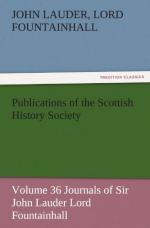Went to Balgonie to sie the Chancelar,[559] which is not his, but the Earle of Levine his children, belonged to the Sibbalds who ware great men and of much power. Within halfe a mile to it stands Balfour, Beatons to their name, a cadet of Lundy, married the heretrix of Balgonie in anno 1606, and tho he changed not his name yet he took the place of his elder brother Lundie.
[559] Earl of Rothes.
Saw by the way Kinglassie, Ayton, Leslie, wheir a most magnificent house is a building: it is neir the Lowmonds, and Falkland, and Lochlevin, in the castle wheirof was Queen Marie keipt. About halfe a mile from it is Markins,[560] wheir Mr. John Ramsay is minister, who is my goodfathers cousin german. Neir it stands Brunton, most pleasantly: it belongs to one Law. Their is much moorish ground in our way.
[560] Now Markinch.
Their was thrie thries[561] (as they called them) in Fyfe, Balveiry Scot, Ardrosse Scot, Dischingtoune of late, but Scot, and Balgonie Sibbald: Balmuto, Bosuel, Weimes of that Ilk, and Rossyth Stuart: then Lundie of that Ilk, Durie of that Ilk, and Colerine, Barclay or else Craighall, Kinninmont.
[561] This seems only to mean
that the three trios of lairds hunted,
not
in couples, but in threes.
On the 5 of May we came over from Bruntiland.
Skein in his de V. Signi:[562] in verbo Clan
Macduff, tells whow on
William Ramsay was Earle of Fife in King David the
2’ds dayes.
[562] Verborum significatione.
Saw in the way to Bruntilland the sands King Alexander the 3’d brak his neck on.
* * * * *
Mr. Joseph Mede,[563] in one of his letters to Doctor Tuisse,[564] speaking anent the manner whow the great continent of America and its circumjacent ilands may probably be supposed to have bein peopled, thinks that the greatest part of that country (especially Mexico and Peru, who ware found the only civilized people amongs them, having both a State and a Church government established among them) was planted by great colonies sent out of the barborous northern nations laying upon the north frozen sea, videlicet, the Tartars and others,[565] who entred America by the Straits of Auvan, and that the most of them hes gone thether since our Saviours coming in the flesh. After which the devil, finding his kingdom ever more and more to decay through the spreading of Christianity upon the face of the wholle earth, which before he keipt inchained in black heathinsme, and being much afflicted with the great din and noyse of the gospell which was come to the utmost ends of the then knowen world, so that he was affraid to lose all his footing hear, he by his oracles and responses encouraged thesse Barbarians (in this Gods ape[566] who called Abram to the land of promise) to desert their native countrie and promised them better habitations in another part (which he might soon do) wheir he might be out of the dread of the gospell and might securly triumph over them as his bond slaves.




